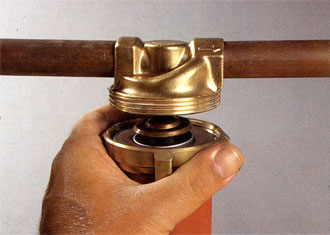Overcoming Water Shortages With Copper
Hot-water recirculation systems largely made of copper are helping overcome the nation's persistent water shortages. The systems eliminate the common wastage of cold water while waiting for hot water to flow. Without recirculation, a family of four can waste 8,000 gallons or more a year.
In recirculation systems, tiny pumps are inserted in 1/2-inch-diameter copper tubing attached at the tap farthest from the water heater. Connected to the water heater, the tubing creates a loop in which water slowly circulates. Opening any tap provides instant pleasurable hot water.
The market leader in the pumps is Laing Thermotech, Inc., Chula Vista, California, states Cedric Grgurich, marketing director. Developed in Europe, where recirculation is more common, the l/150th-hp Laing pump uses copper in its rotor/impeller and has a brass housing. (A larger model has a bronze housing.)
In addition, bronze shut-off and swing- or spring-check valves are used. Also a strainer, usually made of bronze, protects the pump from the debris that can accumulate in a system.
Laing also offers a version of its pump with a timer that can be set to circulate hot water only when it's likely to be needed. For instance, the timer can be set to circulate hot water beginning at 6 a.m., shut down at 9 a.m., start again at 5 p.m. and shut down for the night at 9 p.m. About half the tens of thousands of Laing pumps sold have timers.
The basic pump retails for about $99, and with timer about $129. If installed by a licensed plumber, a complete system can cost from $700 to $1,200 depending on the size of the home. However, handy homeowners can install the systems themselves.
When the pumps are activated, they draw only 33 watts. The small cost of power for the pumps should be recouped in lower water and sewer-usage charges. Reducing these charges, however, is a lesser priority than saving water in water-short communities. Recirculation systems are already mandatory for new homes in the state of Massachusetts and in Fontana, California, and Reno/Sparks, Nevada, according to Ms. Grgurich. She expects other drought-ridden localities to mandate them.
A few California-based home builders are voluntarily installing the systems in homes as a selling point, said Ms. Grgurich. A Laing pump is used in the hot-water recirculation system in the "New Habitat" demonstration home now under construction outside Charleston, South Carolina. The energy efficient home is sponsored by developers and builders in the home construction industry.
The one-moving-part pumps are inherently long lived, Ms. Grgurich noted. A life test of the pumps indicated that they should last ten-plus years. If a pump fails, it takes less than a minute to unscrew it and replace it with a new unit ( see photo below).
 The Laing pump can be unscrewed for service in seconds from the copper tubing (horizontal pipe at top).
The Laing pump can be unscrewed for service in seconds from the copper tubing (horizontal pipe at top).Hot-water recirculation systems have long been installed in hospitals, hotels and apartment houses. In multifamily residences, larger-diameter copper tubing in much-longer lengths and bigger pumps are required. Laing pumps are also used in some solar heaters. The Laing pump can be unscrewed for service in seconds from the copper tubing.
For maximum energy efficiency, the hot water tubing should, of course, be installed to prevent heat loss.
Also in this Issue:
- Copper Outlasts Gold At Boston’s Old State House
- 3,000 Year-Old Copper/Bronze Statue On Display
- Copper Protects Doors and Windows from Salt Spray
- Copper Critical Element in Long-Lived Solar Heater
- Copper Brightens Homes
- Overcoming Water Shortages With Copper
- Stamp of Approval for Copper
